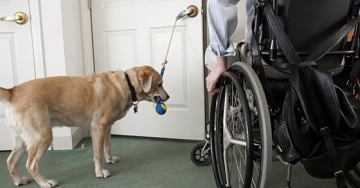Recent News & Blog / Responding to an employee’s request for a service dog

October 4, 2019
There are thousands of service dogs hard at work in the United States today. Assuming it hasn’t happened already, you may eventually field a request from either a new hire or existing employee to bring one of these animals into your workplace.
It’s critical in such instances to take the request seriously and understand your obligations under the Americans with Disabilities Act (ADA), as well as any applicable state laws.
What does the law say?
Title I of the ADA, which addresses employment, doesn’t specifically mention service dogs. However, in Title III, a service animal is defined as:
… any dog that is individually trained to do work or perform tasks for the benefit of an individual with a disability, including a physical, sensory, psychiatric, intellectual or other mental disability. … The work or tasks performed by a service animal must be directly related to the individual’s disability.
The law also includes miniature horses in its definition; otherwise, no other animals are eligible.
Because Title I doesn’t include specifics about service dogs, you should respond to any request to bring such an animal into your workplace just as you would any other reasonable accommodation request. This doesn’t mean automatically granting the request, but you do need to engage in a good-faith interactive process to resolve the employee’s concerns.
How might this work?
The thought of a dog in the workplace may inspire visions of Fido begging for treats in the break room or galloping between rows of cubicles chasing a red rubber ball. But properly trained service dogs are taught to be quiet and unobtrusive.
One common concern is that the dog might trigger allergic reactions in other, susceptible employees. Many employers address this by moving the employee seeking the accommodation to a work area away from anyone allergic to dogs.
Another frequent issue is how to handle bathroom breaks for the animal. Doing so usually involves granting special or extra break times for the employee to take the dog outside. It’s generally within your rights to ask the service dog’s owner to clean up after the animal — both outside and inside (should an accident occur).
One complicating factor in all this is receiving a request for a “comfort animal” rather than a service dog. Comfort animals aren’t trained to assist with specific disabilities. Their purpose is to provide emotional support for the owners. You may have a bit more leeway in denying a request for a comfort animal, but you should still engage in an interactive process and step carefully.
Making the right call
Allowing a service dog can be an effective way to retain a good employee and manage your risk of legal repercussions. But the facts and circumstances of every case will dictate whether you should grant such a request. Consult with an ADA attorney if you’re at all unsure about how to proceed. Contact us for more info.
© 2019